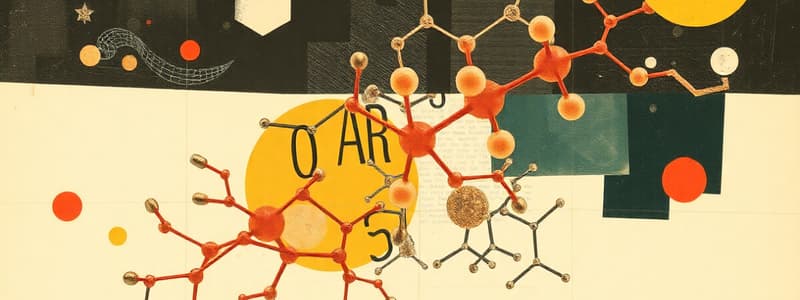Podcast
Questions and Answers
What type of glycosidic bonds are present in amylopectin?
What type of glycosidic bonds are present in amylopectin?
- β 1 → 6 only
- β 1 → 4 only
- α 1 → 4 and α 1 → 6 (correct)
- α 1 → 6 only
Which structural polysaccharide forms the exoskeletons of insects and crustaceans?
Which structural polysaccharide forms the exoskeletons of insects and crustaceans?
- Glycogen
- Starch
- Chitin (correct)
- Cellulose
How many glucose units are linked in an oligosaccharide with a total of 10 glucose units?
How many glucose units are linked in an oligosaccharide with a total of 10 glucose units?
- 8
- 11
- 9
- 10 (correct)
What is the formula for an oligosaccharide composed of 10 glucose units?
What is the formula for an oligosaccharide composed of 10 glucose units?
What is the primary storage polysaccharide in animals?
What is the primary storage polysaccharide in animals?
Which characteristic is NOT true of monosaccharides?
Which characteristic is NOT true of monosaccharides?
What type of isomerism do glucose and fructose exhibit?
What type of isomerism do glucose and fructose exhibit?
What determines the properties and behavior of carbohydrates?
What determines the properties and behavior of carbohydrates?
Which of the following is a function of oligosaccharides?
Which of the following is a function of oligosaccharides?
What distinguishes aldose sugars from ketose sugars?
What distinguishes aldose sugars from ketose sugars?
How many carbon atoms are present in a hexose sugar?
How many carbon atoms are present in a hexose sugar?
What is formed when two monosaccharides bond together through a condensation reaction?
What is formed when two monosaccharides bond together through a condensation reaction?
Which of the following statements about glycosidic bonds is incorrect?
Which of the following statements about glycosidic bonds is incorrect?
What is the primary reason for the difference between alpha and beta glucose?
What is the primary reason for the difference between alpha and beta glucose?
Which of the following statements about glycosidic bonds is false?
Which of the following statements about glycosidic bonds is false?
How does the structure of polysaccharides differ from oligosaccharides?
How does the structure of polysaccharides differ from oligosaccharides?
Which monosaccharide is an example of a pentose?
Which monosaccharide is an example of a pentose?
What is the main structural characteristic that distinguishes alpha glucose from beta glucose?
What is the main structural characteristic that distinguishes alpha glucose from beta glucose?
In the context of disaccharide formation, which process connects two monosaccharides?
In the context of disaccharide formation, which process connects two monosaccharides?
What is a characteristic feature of disaccharides?
What is a characteristic feature of disaccharides?
What role do enzymes play regarding glycosidic bonds in carbohydrates?
What role do enzymes play regarding glycosidic bonds in carbohydrates?
Flashcards are hidden until you start studying
Study Notes
Glucose Structure
- Glucose can exist in both a long chain and a ring form
- The ring form is important for carbohydrate reactions
- Alpha glucose: OH group on C1 projects downwards below C1
- Beta glucose: OH group on C1 projects upwards above C1
Disaccharides
- Formed by condensation reaction between two monosaccharides
- Glycosidic bond: covalent bond between two monosaccharides
- Glycosidic bond determines the properties and behaviour of carbohydrates
- Enzymes are specific for certain glycosidic bonds
Oligosaccharides
- Polymers of 3-10 sugar units
- Often found on cell membranes attached to proteins and lipids
- Function in cell-cell recognition
Polysaccharides
- Polymers of many monosaccharides
- Can differ in branching and connections between monosaccharides
- Function in energy storage and structure
Energy Storage Polysaccharides
- Starch: energy storage in plants
- Amylose: unbranched, α 1 → 4 glycosidic bonds
- Amylopectin: branched, α 1 → 4 glycosidic bonds and α 1 → 6 glycosidic bonds
- Glycogen: energy storage in animals, highly branched similar to amylopectin
Structural Polysaccharides
- Chitin: forms exoskeletons of arthropods and cell walls of fungi
- Polymer of N-acetylglucosamine residues linked by β-1→4 glycosidic bonds
- Cellulose: structural component of plant cell walls
- Polymer of glucose monomers linked by β-1→4 glycosidic bonds
- Peptidoglycan: forms bacterial cell wall
- Composed of sugar chains cross-linked by peptides
Isomerisation
- Isomers have the same molecular formula but different arrangement of atoms
- Structural isomerism: different order of atom connections
- Stereoisomerism: same structural formula but different spatial arrangement
- Enantiomers: mirror images of each other
Monosaccharides
-
General characteristics:
- Water soluble
- White, crystalline solids
- Sweet taste
-
Classification based on:
- Location of carbonyl group:
- Aldose sugars: terminal group is an aldehyde
- Ketose sugars: carbonyl group on a non-terminal carbon
- Number of carbons:
- Triose: 3 carbons
- Tetrose: 4 carbons
- Pentose: 5 carbons
- Hexose: 6 carbons
- Heptose: 7 carbons
- Location of carbonyl group:
Chemical Formula for Oligosaccharide
- The formula for an oligosaccharide containing 10 glucose units is C60H102O51.
Studying That Suits You
Use AI to generate personalized quizzes and flashcards to suit your learning preferences.



